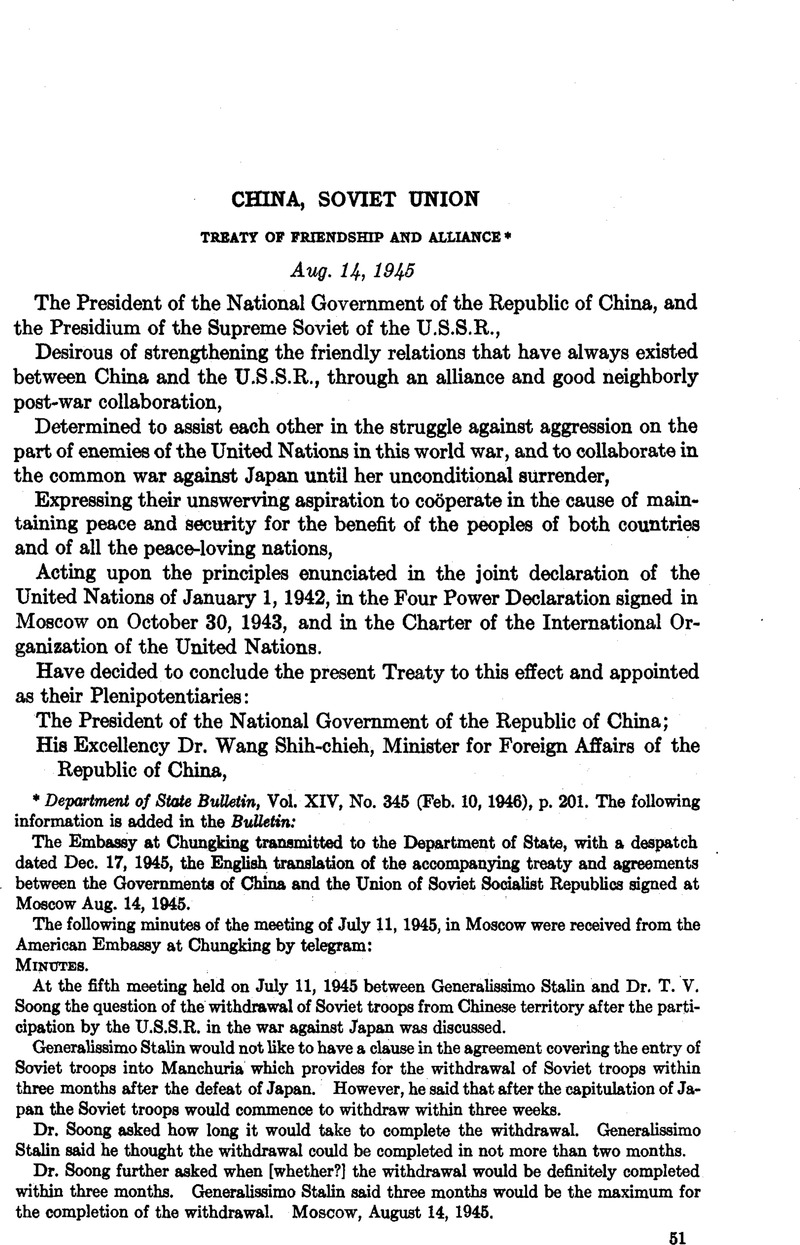No CrossRef data available.
Article contents
Abstract

- Type
- China, Soviet Union
- Information
- American Journal of International Law , Volume 40 , Issue S2: Supplement Official Documents , April 1946 , pp. 51 - 53
- Copyright
- Copyright © American Society of International Law 1946
Footnotes
Department of State Bulletin, Vol. XIV, No. 345 (Feb. 10, 1946), p. 201. The following information is added in the Bulletin:
The Embassy at Chungking transmitted to the Department of State, with a despatch dated Dec. 17, 1945, the English translation of the accompanying treaty and agreements between the Governments of China and the Union of Soviet Socialist Republics signed at Moscow Aug. 14, 1945.
The following minutes of the meeting of July 11,1945, in Moscow were received from the American Embassy at Chungking by telegram: Minutes.
At the fifth meeting held on July 11, 1945 between Generalissimo Stalin and Dr. T. V. Soong the question of the withdrawal of Soviet troops from Chinese territory after the participation by the U.S.S.R. in the war against Japan was discussed.
Generalissimo Stalin would not like to have a clause in the agreement covering the entry of Soviet troops into Manchuria which provides for the withdrawal of Soviet troops within three months after the defeat of Japan. However, he said that after the capitulation of Japan the Soviet troops would commence to withdraw within three weeks.
Dr. Soong asked how long it would take to complete the withdrawal. Generalissimo Stalin said he thought the withdrawal could be completed in not more than two months.
Dr. Soong further asked when [whether?] the withdrawal would be definitely completed within three months. Generalissimo Stalin said three months would be the maximum for the completion of the withdrawal. Moscow, August 14, 1945.
References
* Department of State Bulletin, Vol. XIV, No. 345 (Feb. 10, 1946), p. 201. The following information is added in the Bulletin:
The Embassy at Chungking transmitted to the Department of State, with a despatch dated Dec. 17, 1945, the English translation of the accompanying treaty and agreements between the Governments of China and the Union of Soviet Socialist Republics signed at Moscow Aug. 14, 1945.
The following minutes of the meeting of July 11,1945, in Moscow were received from the American Embassy at Chungking by telegram: Minutes.
At the fifth meeting held on July 11, 1945 between Generalissimo Stalin and Dr. T. V. Soong the question of the withdrawal of Soviet troops from Chinese territory after the participation by the U.S.S.R. in the war against Japan was discussed.
Generalissimo Stalin would not like to have a clause in the agreement covering the entry of Soviet troops into Manchuria which provides for the withdrawal of Soviet troops within three months after the defeat of Japan. However, he said that after the capitulation of Japan the Soviet troops would commence to withdraw within three weeks.
Dr. Soong asked how long it would take to complete the withdrawal. Generalissimo Stalin said he thought the withdrawal could be completed in not more than two months.
Dr. Soong further asked when [whether?] the withdrawal would be definitely completed within three months. Generalissimo Stalin said three months would be the maximum for the completion of the withdrawal. Moscow, August 14, 1945.




